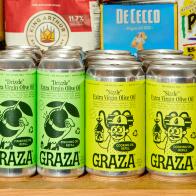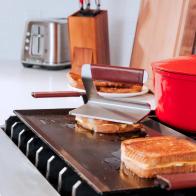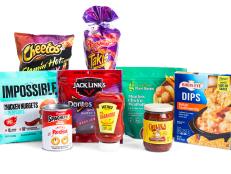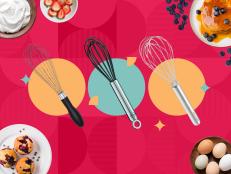Food Network Magazine's Frozen Food Hall of Fame
Let’s hear it for the coolest freezer-aisle innovations of all time!


If you’ve been shopping in the freezer section more than usual, you’re not alone. Americans spent more than $65 billion on frozen food in 2020 (up more than 20% from 2019), and sales have risen again this year, suggesting that what started as a pandemic trend could be turning into a long-term habit. A wave of exciting new products is part of the draw, but nostalgia is a factor, too: We’ve been rediscovering old-school favorites like Eggo waffles, Stouffer’s entrées and Hot Pockets. Here are some of the most notable freezer products of the past century — and a few that didn’t turn out to be so cool after all.
1930: Birds Eye Frozen Peas

Clarence Birdseye launched an entirely new industry when, after learning food preservation techniques from Inuit fishermen, he patented a flash-freezing machine that could preserve vegetables at their peak. He promised peas that were "as gloriously green as any you will see next summer."
1946: Orange Juice Concentrate

Starting the day with OJ wasn’t possible for many Americans until government researchers developed a concentrate that could be easily stored and shipped. It was named Minute Maid because of how quickly you could prepare it.
1952: Mrs. T’s Pierogies

Ted Twardzik set out to bring his mom’s potato-and-cheese Polish dumplings to the masses in the 1950s, and today the company sells more than half a billion frozen pierogi a year!
1953: Gorton’s Fish Sticks

World War II meat rationing gave Americans a newfound appetite for seafood, and Gorton’s satisfied it with sticks of breaded whitefish. The company later marketed them to school lunch programs, and a cafeteria staple was born.
1953: Eggo Waffles

Making waffles required batter and a waffle iron until these hit the market. Inventors Frank, Anthony and Samuel Dorsa briefly called them Froffles but then went with Eggos, a nod to their earlier business making mayonnaise.
1954: Swanson Turkey Dinner

Faced with a surplus of frozen turkey one Thanksgiving and inspired by ready-to-heat airline meals, Swanson created what was probably the first "TV Dinner." It was 98 cents and came with cornbread dressing, buttered peas and mashed potatoes.
1981: Lean Cuisine

In the diet-obsessed ’80s, sales of Stouffer’s low-cal Lean Cuisine dinners soared and stores struggled to keep up with demand. The meals had fewer than 300 calories, compared with 850 for an average Stouffer’s entrée.
1983: Hot Pockets

Before they became fodder for comedians, the microwavable stuffed sandwiches were a breakthrough concept: hearty handheld frozen meals with high-tech packaging. Each came with a paperboard sleeve that helped crisp the bread.
1993: Mochi Ice Cream

Frances Hashimoto of Mikawaya, a Japanese bakery in Los Angeles, came up with the genius idea to fill sweet rice dough with ice cream — and a mochi ice cream craze began. Her original brand is still sold, along with its popular sister brand My/Mochi.
1995: DiGiorno Rising Crust Pizza

DiGiorno didn’t invent frozen pizza but the company has long been the country’s top-selling brand — and it won raves in the ’90s with this restaurant-inspired pie. The crust puffs up as it bakes.
2010: Saffron Road Frozen Meals

These meals, which include lamb saag and chicken tikka masala, were a big step toward a more inclusive freezer aisle: They were the first nationally available certified-Halal meals in the category.
Freezer Flops:
Libbyland Adventure Dinners

Marketed as the first frozen dinners for kids in the 1970s, these themed meals included Sea Diver’s Dinner and Pirate Picnic. The characters were a hit; the food, not so much.
Morton Twinkie Suppers

For a brief time in the ’70s, Morton tried to capitalize on our love of Twinkies by packaging them with entrées like a burger or spaghetti.
Colgate Lasagna

The toothpaste brand briefly experimented with a line of frozen entrées, including beef lasagna, in the ’80s.
Swanson Le Menu Dinners

This line of fancy microwavable meals, which included dishes such as beef sirloin tips in mushroom-wine gravy, was meant to compete with restaurants. The restaurants won.
Photography Credits:
Peas: Getty Images.
Minute Maid and Swanson Dinner: Jason Liebig.
Lean Cuisine and Le Menu: Gaslight Advertising.
Libbyland Dinners: Jamie Bradburn.
Twinkies: Alamy.
Colgate Lasagna: Museum of Failure.
Story Credits:
All text written by Francesca Cocchi for Food Network Magazine.
Related Links:























































